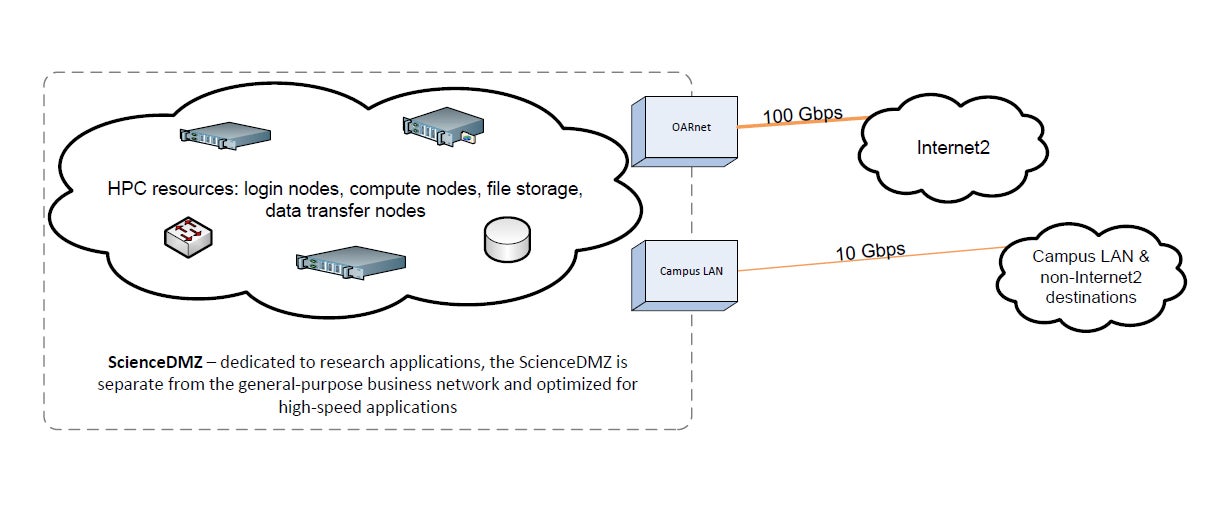The Case Western Reserve University (CWRU) Science DMZ is a portion of the network, built at or near the campus or laboratory's local network perimeter that is designed such that the equipment, configuration, and security policies are optimized for high-performance scientific applications rather than for general-purpose business systems or "enterprise" computing.
Availability + Service Expectations
-
The Science DMZ is currently available to Case faculty for academic and research purposes.
-
Science DMZ Services:
-
High speed backbone connecting High Performance Computing (HPC) components within the computer room
-
Connection to Internet2 via OARnet using a 100 Gigabits per second (Gbps) uplink
-
Data Transfer Node (DTN) to send and receive data using a 40 Gbps uplink
-
Performance monitoring via perfSONAR node
-
Current Hardware + Operating Systems
-
The Science DMZ encompasses the High Performance Computing nodes, network storage, a perfSONAR node for monitoring the network, and a data transfer node used for sending or receiving files. All are connected with the highest-speed network interface of which they are capable (10 Gbps, 25 Gbps, 40 Gbps or 100 Gbps depending on hardware limitations). The LAN connections are served by Mellanox and Arista switches.
Implementation
-
The concept of a Science DMZ was suggested by Eli Dart of ESnet (Energy Sciences Network), Brent Draney of NERSC and Paul Henderson of PPPL 2009. ESnet continues to refine the best practices and maintains an extensive knowledge base on its website.
-
CWRU used the ESnet design and implemented its own version of the Science DMZ in the summer of 2014. The project was funded through the National Science Foundation CC-NIE Award 1340938 (Bielefeld, PI).
Associated RCCI Resources + Services
Services
-
Consultation Services - RCCI can provide the necessary information about the existing Core facility (boilerplate language), suggest the appropriate computational hardware and storage for the proposal, including the necessary quotes, and execute the proposed computational plan upon the award being funded.
Resources
-
External Resources - While our resource serves well for many research uses, it is not of adequate size to handle larger computational tasks that may require several hundred or several thousand simultaneous processors. For those larger jobs, there are other resources available to CWRU researchers that are both free and commercially available.
- Globus - Globus is a web-based method that uses grid FTP to easily and quickly transfer files. Anyone that has an HPC login can use Globus. The Data Transfer Node is enrolled as CWRU#DTN1 and automatically mounts the user’s home directory and provides access to HPC storage.
Who manages the Science DMZ Service?
- The HPC Service Manager is Cindy Martin. She can be reached at hpc-support@case.edu.
How can I get the Science DMZ Service?
- Contact hpc-support@case.edu with any questions regarding the account application process.
Where can I find more information about UTech Research Computing and the HPC?
- In addition to the Additional HPC Information section below, please view our Research Computing Brochure.
-
General information about Science DMZ standards and methods can be found at the ESnet Science DMZ website.
-
The Case Western Reserve University implementation is represented in Figure 1.



